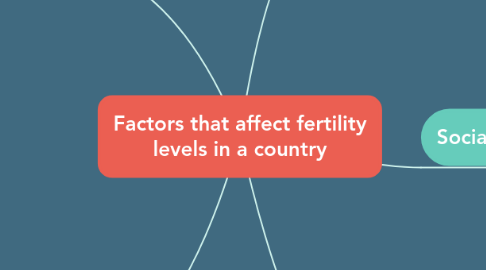
1. Economic
1.1. Employment opportunities
1.1.1. With the prospect of a career, women may have less children and marry later. e.g. the average marital age in the UK is 30.
1.1.2. Reduced access to formal employment and other income earning opportunities means women are forced to devote most of their time and energy to child bearing.
1.2. The cost of having a children
1.2.1. Children are seen as economic assets in LEDCs. They can be used as workers on land or to bring in more income.
1.2.2. The time spent in education and the cost of childcare makes it more expensive to have a child. In the UK (TFR 1.66) the estimated cost of raising a child to 21 is £166,000.
2. Demographic
2.1. Infant mortality rates
2.1.1. High birth rates to compensate a high infant mortality rate e.g. Nigeria with a birth rate of 5.16.
2.1.2. Reduced infant mortality rate reduces the need for lots of children for security. e.g. Japan’s birth rate of 7.64 with an infant mortality rate of 2.79.
2.2. Age structures
2.2.1. Countries with a large proportion of young people may continue to see a population increase due to population momentum.
2.2.2. Countries with a small proportion of youth face population decline even if birth rates per woman increase e.g. Japan.
3. Social/Culture
3.1. Level of healthcare
3.1.1. Improvements in health care, sanitation & diet lead to a drop in infant mortality rate e.g. The Demographic Republic of Congo has a total fertility rate of 6.91 and 0.088 doctors per 1000 people.
3.2. Level of education
3.2.1. In some countries, access to healthcare and education may be limited e.g. Afghanistan, total fertility rate of 7.7 with 0.17 doctors per 1000 & a female literacy rate of 13%.
3.3. Religion
3.3.1. In many parts of the world religion/tradition demands high rates of reproduction
3.4. Status of Women
3.4.1. Women in some countries are obliged to produce as many children as possible e.g. Nigeria, total fertility rate 4.9.
4. Political
4.1. Pressure from the governement
4.1.1. Some governments will try to influence the rate of population growth e.g. The chinese attempting to reduce the birth rate or Japan attempting to increase it.
5. Environmental
5.1. Climate
5.1.1. Weather conditions may not be suitable for the birth of a child
5.2. Pollution
5.2.1. Air pollution or water pollution in countries where heavy industries are present

